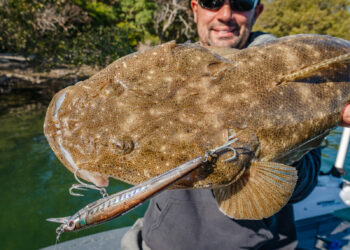FOR sportfishers everywhere, and freshwater addicts in particular, peacock bass are one of those “bucket list” species that keen anglers dream of. This group of tropical South American freshwater fishes are actually not bass at all, but are instead members of the Family Cichlidae. However, unlike the thousands of species of their close relatives the cichlids, angelfish, oscars, discus and tilapias of aquarium fame, peacock bass are desirable sportfish for several reasons. Firstly their size. Peacock bass are the largest of the cichlids, with some species growing to nearly a meter long. Unlike most other cichlids, they are top level piscivorous predators with a unique feeding method – think a mixture of the ambush rush of a PNG black bass followed by the “suction feeding” boof of a barra. Their explosively violent surface strikes are usually followed by strong runs and energetic jumps, behaviour that has lead many anglers to consider peacock bass as being one of the worlds most exciting freshwater sportfish.
For such an immensely popular sportfish and important food fish for those living in the Amazon basin, it’s surprising that the scientific community had little to do with peacock basses until quite recently. The first species of the group, the butterfly peacock, was described as Cichla ocellaris way back in 1801. This is a relatively small species, growing to around 7 kg, but it possessed the distinctive body shape and ocellated colouration characteristic of the group, including the distinctive caudal ocellus (or “peacock spot”) on the tail. The latter is thought to potentially confuse predators by mimic the eye, thus leading would be attackers to question whether their prey was coming or going. The second species to be described in 1821 was the three bar or giant peacock bass Cichla temensis. This species is the worlds largest cichlid, growing to 90+ cm and over 12 kg. As early explorers penetrated deeper into the Amazon other species followed, but until 2006 there were only 6 species of Cichla recognised by the scientific community. Only in the past 10 years have several more species been described, with 15 species of peacock bass now recognised being differentiated by colour patterns, fin ray and scale counts and the localities where they occur. The situation is in a state of flux and fish taxonomy experts are predicting that perhaps there may be between 20 and 30 species in the group, although there is some genetic evidence of hybridization which makes it difficult to predict the final number.
The reasons why there are so many species of peacock bass no doubt stems from a combination of the sheer size of the Amazon River Basin, and the specialist nature of cichlid fishes. Cichlids are renowned as highly specialised fishes that readily speciate when given enough room to do so, with the 500 odd species of cichlids that occur in Lake Victoria in Africa a prime example of this. Of course the various peacock bass species have much in common – sexes are separate and easily identified by the fact that male fish are more brightly coloured, and with maturity develop a prominent frontal hump on the head. They generally mature within one (males) or two years (females) after which spawning can occur repeatedly thoughout the year. Each spawning period the female deposits a relatively small number (1000’s) of sticky eggs on a convenient substrate (often a flat stone in shallow water) before brooding the larvae in their mouths once the eggs hatch. When adult fish are guarding their young on the “nest” they can become extremely territorial and aggressive, a trait which lucky anglers can exploit to generate those explosive surface strikes when using topwater lures.
The mouth brooding strategy of the peacock bass vastly improves the survival rates of the young fish, no doubt contributing to the success of the species wherever they have been introduced into suitable new locations. For example, both butterfly peacock and the giant peacock bass were introduced into Florida in the USA in the 1980s as gamefish and for biological control of other exotic ornamental fishes that had established wild populations there. Indeed, peacock bass have been introduced into many areas outside their native range, often to the benefit of sportfishers, but their aggressive behaviour usually results in significant negative impacts on native fish species in the water bodies being stocked. Because of this there is little hope of them ever being introduced into Australia, which means Aussie anglers working on their bucket list will have no choice but to make the pilgrimage to the Americas to get their sample of peacock action.





















